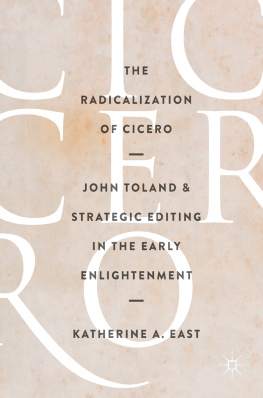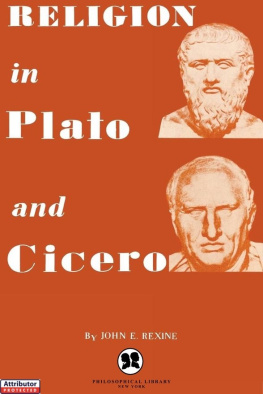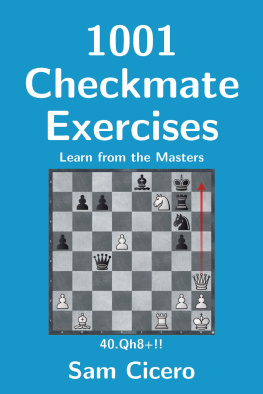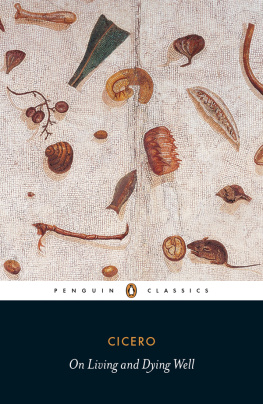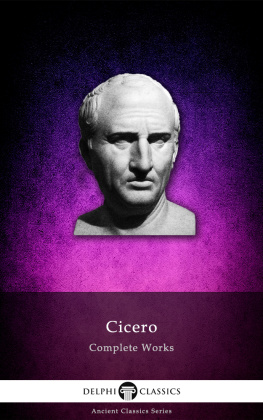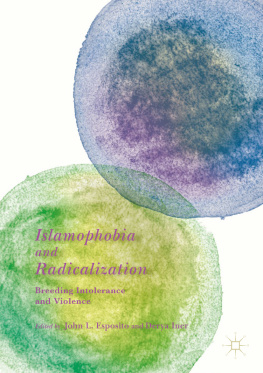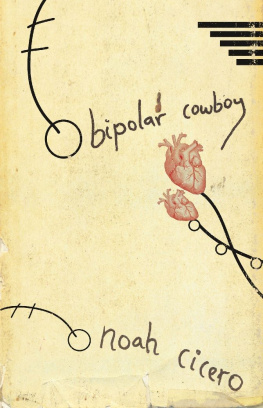In 1712 John Toland (16701722)a man whose reputation for directing his intellectual writing towards provocation, heterodoxy, and trouble-making was well establishedcomposed in Latin a work entitled Cicero Illustratus , in which he laid out his plans for completing a new edition of Ciceros complete works. Cicero Illustratus is Tolands attempt to vindicate that claim, using a combination of erudition , scholarly strategy, and vigorous polemic to argue for both the necessity of a new edition, and for his own ability to successfully execute the task. The proposed edition of Ciceros works may never have been completed, but the picture Toland presents in Cicero Illustratus is comprehensive, embracing not only his assessment of the value of Cicero and the processes whereby that value had been eroded, but also his plans for all the tasks he as editor would be undertaking, from criticism of the text to composition of the prefatory life to the printing type which would be used. The result is a treatise of 73 pages which encompasses myriad themes relating to the situation and status of Cicero in early Enlightenment England, while also subjecting the Ciceronian editorial tradition to a critical review, and addressing the question of the appropriate conduct of textual scholarship . A consistent presence in these deliberations is Toland himself, whose capabilities as an editor and whose understanding of Cicero remain an explicit and implicit concern throughout.
Permeating this unique work is crucial new material relating to the cultural legacy of the ancient world, the history of scholarship , and the intellectual history of the early Enlightenment . Cicero Illustratus itself, previously unpublished, and in scholarship discussed as an independent text only briefly towards the end of Matthew Foxs Ciceros Philosophy of History , is here made fully accessible for the first time. As a consequence, topics that have previously been neglected in scholarship are given the opportunity for long overdue consideration. First, the history and conduct of the Ciceronian editorial tradition in the age of the printed book are the subjects of extensive criticism throughout Cicero Illustratus , functioning as a touchstone against which Toland communicated his own editorial plans. This demands acknowledgement of the emphatically influential role these editions, and their transmission of the Ciceronian text, played in determining how Cicero and his works were received and understood, a role which has been previously confined to textual scholarship with minimal reference to the broader cultural implications of these editions. Second, the place of classical scholarship in John Tolands works requires investigation in order to contextualise Cicero Illustratus , directing scholarly attention towards a facet of Tolands intellectual horizon too often overlooked in favour of the gallery of the great men of the radical tradition usually at the centre of attempts to deconstruct Tolands thought. Establishing the classical sphere in Tolands oeuvre has notable repercussions, most significant of which is the question, has the importance of Cicero to the radicalism of the early Enlightenment been fundamentally misunderstood?
Creating Cicero Illustratus
In the second chapter of Cicero Illustratus Toland integrates a romanticised and frankly fawning narrative of his first meeting with Prince Eugene of Savoy , recalling that day on which (most eminent B aron ) I was led for the first time by you to the most serene Eugene of Savoy, a name honoured by the whole world, and particularly revered by the cultivators of literature, since he himself is the light and glory of all the good arts! Competently supported by Hohendorf, Eugene used his diplomatic and military travels, together with connections forged with men such as Toland, to collect a vast range of works, which filled the specially designed library in his Belvedere in Vienna with over 15,000 printed books and 237 manuscripts.
Toland sourced texts on Eugenes behalf, but more significantly he engaged in the circulation of texts to Eugene and his literary circle, texts which were more often than not of a subversive and heterodox nature. Given the heterodox nature shared by these works, Tolands decision to direct a proposal for a seemingly traditional piece of classical scholarship at Eugene seems anomalous, yet it forms part of a larger pattern at work in Tolands career.
When Toland travelled to the Continent in 1707, and went on to meet Eugene and begin these literary exchanges, it was because his efforts at carving a career for himself in English politics had faltered. Toland had first achieved notoriety in 1696 with the publication of Christianity Not Mysterious , a rebuttal of the assertion that anything in Christianity could exist beyond the reach of mans reason. By this path, Toland worked to position himself for more permanent employment.
Crucial to this goal was Tolands relationship with Robert Harley . Anglia Libera , a work published in 1701 in which Toland celebrated the Act of Settlements confirmation of the Hanoverian Succession, had rehabilitated his standing sufficiently to win him a position from Harley as secretary on the embassy to Hanover accompanying Lord Macclesfield, in order to present the Act to the Electress Sophia of Hanover. When Toland returned from this endeavour in 1704, he became all the more involved with Harley, who by that time held the position of secretary of state. It was under Harleys direction that Toland produced The Memorial of the State of England in 1705; he invited Toland to craft a response to The Memorial of the Church of England , which had been written by incensed High Churchmen accusing the Whigs of pursuing the destruction of the Church of England . Tolands work was in turn attacked by one Thomas Raulins , who used the opportunity to criticise Robert Harley ; Toland again penned a response, entitled A Defence of Her Majestys Administration . In spite of these labours, Toland was not rewarded with any tangible position or status, a situation which increasingly frustrated him. This disappointmentcompounded by Harley being forced from office in 1708 by an alliance between John Churchill , future Duke of Marlborough , and the Tory Sidney Godolphin led to the sojourn on the Continent during which Toland met Eugene.
It was this disillusionment with the political establishment which encouraged Toland to pursue his heterodox interests through the practice of scholarship . The views expressed in Christianity Not Mysterious did not cease to exist with Tolands move into political writing; it was following his European travels as part of Macclesfields entourage that Toland produced the Letters to Serena , a series of essays which looked back to the existence of a natural religion in the ancient past, and the corruption of that belief by the imposture of priests. In the end, Toland repudiated Harley, severing their ties with the work The Art of Restoring in 1714, in which Harley was compared to that ally of the Stuarts, George Monk.
Even more significant, particularly for Cicero Illustratus , was Tolands utter disgust with Harleys attempts to negotiate a peace agreement with France to end the War of the Spanish Succession , a move which Toland feared would threaten Protestant liberties throughout Europe, and the Hanoverian Succession, so crucial to English liberties. This further unified Toland with Eugene, who from his position as one of the foremost generals campaigning in the war vigorously opposed such a peace. In fact, Cicero Illustratus was composed in the weeks after Eugene had travelled to England to attempt to persuade Harley and Queen Anne against pursuing such a treaty. Toland describes the visit in the second chapter of Cicero Illustratus , flattering Eugene with his depictions of the rapturous joy of the people of Britain on being able to receive him, and expressing his anger and disappointment at Eugenes treatment by Harley, who rejected his overtures with behaviour bordering on disrespect. It was at this momentwith the threat of a French treaty imminent, with a feeling of disappointment and betrayal in Harley fresh in his mind, and with a long period of frustration behind himthat Toland composed Cicero Illustratus .

